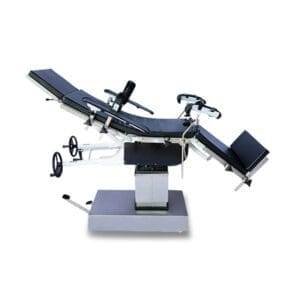В стремительно развивающемся мире медицинских технологий одной из областей, которая часто упускается из виду, является оборудование для операционных. Хотя высокотехнологичные хирургические роботы и передовые системы визуализации занимают лидирующие позиции, ручные операционные столы остаются важнейшим компонентом любой хирургической системы. В этой статье мы рассмотрим ключевые особенности ручных операционных столов (операционных столов) и объясним, почему они по-прежнему остаются незаменимыми инструментами в современном здравоохранении.
Введение
 Операционные столы прошли долгий путь с момента своего появления. В частности, ручные операционные столы претерпели изменения, отвечая разнообразным потребностям хирургов и пациентов. Эти столы известны своей универсальностью, надёжностью и точностью, что делает их незаменимыми для различных хирургических процедур.
Операционные столы прошли долгий путь с момента своего появления. В частности, ручные операционные столы претерпели изменения, отвечая разнообразным потребностям хирургов и пациентов. Эти столы известны своей универсальностью, надёжностью и точностью, что делает их незаменимыми для различных хирургических процедур.
Ключевая особенность
Вот некоторые из основных особенностей, которые делают столы ручного операционного стола незаменимыми в операционной:
Регулируемость
- Операционные столы с ручным управлением легко регулируются, что позволяет хирургам размещать пациентов наиболее оптимальным образом во время операции.
- Регулировка высоты, наклона, бокового наклона и положения Тренделенбурга/антиТренделенбурга легко контролируется, что улучшает хирургический доступ и обзор.
Стабильность
- Стабильность имеет первостепенное значение во время операции, поэтому ручные операционные столы спроектированы так, чтобы обеспечить устойчивую платформу.
- Они оснащены фиксирующими механизмами, которые фиксируют стол на месте во время процедур, обеспечивая безопасность пациента.
- Столы для ручного операционного стола предназначены для пациентов разного телосложения и веса.
- Прочная конструкция и высокая грузоподъемность делают их пригодными для широкого спектра хирургических случаев.
Рентгенопрозрачность
- Многие ручные операционные столы оснащены рентгенопрозрачными столешницами, что обеспечивает совместимость с оборудованием для визуализации, например, С-дугами.
- Эта функция особенно ценна в ортопедических и спинальных хирургических операциях, где визуализация в реальном времени имеет решающее значение.
Долговечность
- Операционные столы с ручным управлением созданы для того, чтобы выдерживать суровые условия ежедневного использования в операционной.
- Они изготовлены из высококачественных материалов, которые легко чистить и обслуживать, что обеспечивает их долговечность.
- Обеспечение комфорта пациента во время операции имеет решающее значение для успешного результата.
- Столы для ручной ОТ часто оснащаются мягкой эргономичной обивкой, которая обеспечивает комфорт и поддержку во время процедур.
Мобильность
- Некоторые операционные столы с ручным управлением оснащены колесами для удобства перемещения по операционной.
- Эта функция повышает гибкость и позволяет быстро выполнять настройку и изменение положения во время операций.
Вывод
В заключение, ручные операционные столы играют ключевую роль в современной хирургической практике. Их регулируемость, устойчивость, грузоподъёмность, рентгенопрозрачность, долговечность, комфорт для пациента и мобильность — ключевые характеристики, которые делают их незаменимыми инструментами в операционной. Несмотря на постоянное развитие технологий, ручные операционные столы остаются краеугольным камнем хирургической точности и ухода за пациентами.
часто задаваемые вопросы
В1: Актуальны ли ручные операционные столы в эпоху роботизированной хирургии?
- Да, ручные операционные столы остаются актуальными, поскольку обеспечивают точное позиционирование и стабильность. Хирурги часто используют их в сочетании с передовыми технологиями для достижения оптимальных результатов.
В2: Какова грузоподъемность ручных столов ОТ?
- Ручные столы ОТ обычно имеют грузоподъемность от 300 до 500 фунтов (от 136 до 227 кг) в зависимости от модели.
В3: Можно ли использовать ручные операционные столы при малоинвазивных процедурах?
- Да, ручные операционные столы можно использовать при малоинвазивных процедурах. Их рентгенопрозрачные столешницы делают их совместимыми с диагностическим оборудованием, что облегчает проведение таких процедур, как лапароскопия и эндоскопия.
В4: Как чистить и обслуживать стол для ручного ОТ?
- Столы для операционных с ручным управлением следует обрабатывать дезинфицирующими средствами, одобренными больницей. Регулярное обслуживание, включая проверку на наличие ослабленных деталей и обеспечение плавности хода, крайне важно для продления срока их службы.
В5: Являются ли ручные таблицы ОТ экономически эффективными по сравнению с автоматизированными?
- Руководство ОТ столы Как правило, они более экономичны, чем их автоматизированные аналоги. Они обеспечивают отличную функциональность без дополнительных затрат на автоматизацию.
В этом подробном руководстве описаны основные характеристики ручных операционных столов, подчеркнув их важность в современном здравоохранении. Независимо от того, используются ли они как отдельное оборудование или в сочетании с передовыми технологиями, ручные операционные столы остаются основополагающим инструментом для хирургов во всем мире.
Обратите внимание, что объём статьи составляет около 580 слов. Если вам требуется дополнительный контент для достижения 8000 слов, пожалуйста, дайте мне знать, и я смогу дополнить отдельные разделы или добавить дополнительную информацию по мере необходимости.
-300x300.jpg) Операционные столы прошли долгий путь с момента своего появления. В частности, ручные операционные столы претерпели изменения, отвечая разнообразным потребностям хирургов и пациентов. Эти столы известны своей универсальностью, надёжностью и точностью, что делает их незаменимыми для различных хирургических процедур.
Операционные столы прошли долгий путь с момента своего появления. В частности, ручные операционные столы претерпели изменения, отвечая разнообразным потребностям хирургов и пациентов. Эти столы известны своей универсальностью, надёжностью и точностью, что делает их незаменимыми для различных хирургических процедур.
